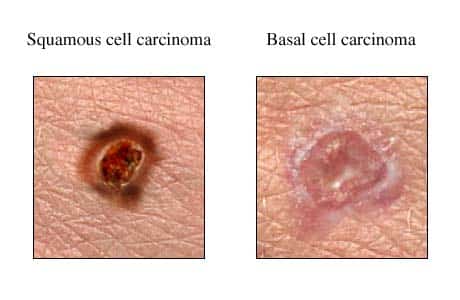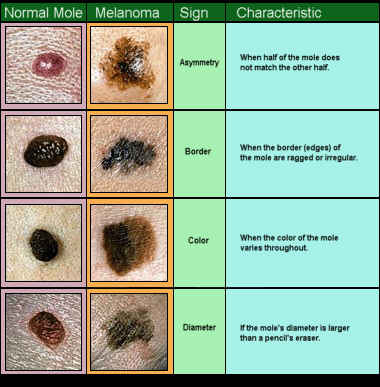Gone are the days when people sent children outside to play to get a little color in their cheeks. They know too much about the dangers of unprotected sun exposure and the threat of skin cancer. Or do they? Despite the fact that 58% of parents remembered hearing about the importance of protecting their children from the sun, children are still playing in the sun without sunscreen or protective clothing (3., p 1). Sunburn is the most preventable risk factor of skin cancer. Skin type and family history cannot be changed. Protection from the sun and education of the potential hazards of the sun need serious attention. The American Cancer Society estimates that over 850,000 cases of skin cancer will occur in the United States during 1996. Of those cases, they predict that 9,430 will end in death (4., p 1). Apparently, Americans still do not have an adequate amount of prevention information to help reduce the disfigurement and mortality from this cancer.
Exposure to the ultraviolet radiation from the sun is the most frequently blamed source of skin cancer. Due to the reduction of ozone in the earth’s atmosphere, UV radiation is higher today than it was several years ago. Ozone serves as a filter to screen out and reduce the UV light that reaches the earth’s surface and its people. Very simply, sunburn and UV light can damage the skin and lead to skin cancer (1., p 1). The American Cancer Society also faulted repeated exposure to x-rays, artificial forms of UV radiation like tanning beds, and contact with chemicals like coal tar and arsenic as other causes of skin cancer (4., p 1). Additionally, if there is a history of skin cancer in the family, an individual may be at a higher risk (1., p 1). Individuals who have experienced only one serious sunburn have increased their risk of skin cancer by as much as 50% (1., p 4).
There are three main types of skin cancer: basal cell carcinoma, squamous cell carcinoma, and malignant melanoma. Basal cell carcinoma  usually imposes itself on areas of the skin that have been exposed to the sun. It usually appears as a small raised bump with a smooth shiny surface. Another type resembles a scar that is firm to the touch. Although this specific type of skin cancer may spread to tissue directly surrounding the cancer area, it usually does not spread to other areas of the body (9., pp 2-3).
usually imposes itself on areas of the skin that have been exposed to the sun. It usually appears as a small raised bump with a smooth shiny surface. Another type resembles a scar that is firm to the touch. Although this specific type of skin cancer may spread to tissue directly surrounding the cancer area, it usually does not spread to other areas of the body (9., pp 2-3).
Squamous cell carcinoma growths also appear most frequently on areas of the body that have been exposed to the sun. These areas can include the hands, lower lip, forehead, and the top of the nose. Additionally, skin that has been exposed to x-rays, chemicals, or has been sunburned can host these tumors. The squamous tumors may feel scaly or develop a crusty appearance. Some growths may bleed. These particular tumors may spread to lymph nodes in the surrounding area (9., pp 2 -3).
Malignant melanoma is a far more serious type of skin cancer. It can spread quickly to other parts of the body through the lymph system or blood. This type of skin cancer is more common among adults. Findings have indicated that men most often develop melanoma on the trunk of the body. Whereas, women most often develop it on the arms and legs (6., pp 2-3). The warning signs of melanoma are: changes in the color, size, or shape of a mole, bleeding or oozing from a mole, or a mole that is hard, lumpy, swollen, and is tender to the touch, or feels itchy. A new mole can also be an indicator of melanoma. A simple “ABCD” rule outlines the warning signs of melanoma. “A” is for asymmetry. One half of the mole does not match the other. “B” is for border irregularity. The edges are ragged, notched, or blurred. “C” is for color. The pigmentation is not uniform. “D” is for a diameter of greater than 6mm. Any progressive increase in size should be of particular concern (8., p 1).
For both basal and squamous cell carcinomas, surgery is the most common treatment. Electrosurgery is the process in which the cancer is scooped out with a sharp instrument and then an electric current is used to burn the edges around the site to kill any remaining cancer cells. Cryosurgery freezes the tumor to kill the diseased tissue with liquid nitrogen. Simple excision cuts the cancer from the skin along with some of the healthy tissue around it. Micrographic surgery removes the cancer and as little normal tissue as possible. During this surgery, the doctor removes the cancer and then uses a microscope to look at the cancerous area to make sure no cancer cells remain. This particular treatment has the highest 5-year cure rate. Laser therapy uses a narrow beam of light to remove the cancer cells. Surgery may leave a permanent scar on the skin. Depending on the size of the cancer removed during surgery, skin grafting may be necessary. Radiation therapy uses x-rays to kill cancer cells and shrink tumors. Chemotherapy uses drugs to kill the cancer cells. Topical chemotherapy is often administered as a cream or lotion placed on the affected skin to kill the cancer cells. Systematic chemotherapy is a treatment administered in the form of a pill or injection. This allows the drug to enter the bloodstream, travel through the body and kill cancer cells. Systematic chemotherapy is in the process of being tested in clinical trials. Biological therapy, or immunotherapy tries to get the person’s own body to fight the cancer. It uses materials made from the infected person’s body to boost, direct, or restore the body’s own natural defenses against the cancer. Photodynamic therapy uses a certain type of light and a special photosensitive chemical to kill cancer cells (9., pp 2-5).
Malignant melanoma is classified by stages. In Stage 0 melanoma, abnormal cells are localized to the outer layer of the skin cells and do not invade deeper tissues. At stage I, cancer is found in the epidermis and/or the dermis, but it has not yet spread to nearby lymph nodes. The tumor measures less than 1.5 millimeters thick. At stage II, the tumor measures 1.5 millimeters to 4 millimeter thick. The cancer has spread to the lower part of the dermis, but not into the tissue below the skin or into the nearby lymph nodes. At stage III, indications are that the tumor has spread to nearby lymph nodes or there are additional growths between the original tumor and the lymph nodes in the area. At stage IV, the tumor has spread to other organs or to lymph nodes far away from the original tumor. The type of treatment is based on the stage of the cancer. Four of the most common kinds of treatments are: surgery, chemotherapy, radiation therapy, and biological therapy. Surgery is the primary treatment for all stages of melanoma. After surgery, chemotherapy is normally used to kill any cancer cells that may remain (6., pp 2-5).
invade deeper tissues. At stage I, cancer is found in the epidermis and/or the dermis, but it has not yet spread to nearby lymph nodes. The tumor measures less than 1.5 millimeters thick. At stage II, the tumor measures 1.5 millimeters to 4 millimeter thick. The cancer has spread to the lower part of the dermis, but not into the tissue below the skin or into the nearby lymph nodes. At stage III, indications are that the tumor has spread to nearby lymph nodes or there are additional growths between the original tumor and the lymph nodes in the area. At stage IV, the tumor has spread to other organs or to lymph nodes far away from the original tumor. The type of treatment is based on the stage of the cancer. Four of the most common kinds of treatments are: surgery, chemotherapy, radiation therapy, and biological therapy. Surgery is the primary treatment for all stages of melanoma. After surgery, chemotherapy is normally used to kill any cancer cells that may remain (6., pp 2-5).
Individuals that have treatment for basal cell carcinoma should be clinically examined every 6 months for at least 5 years. Thereafter, an examination for recurrent growths or new tumors should be done on an annual basis. It has been found that 36% of individuals who develop a basal cell carcinoma will develop a second primary basal cell carcinoma within 5 years. Since squamous cell carcinomas have definite metastatic potential, these patients should follow a 3 month re-examination schedule for the first several years, and then follow a 6 month schedule of examinations for an indefinite period of time (10., pp 4-6). Overall, there is an increased incidence of second primary melanomas in affected individuals. A minimum of 3 percent will develop second melanomas within 3 years. Thus, patients need close follow up for the development of subsequent primary melanomas. An appropriate interval of re-examination may be 6 months for patients with atypical moles and without a family history of melanoma. If patients have not shown evidence of recurrence or a second primary melanoma by the second anniversary of diagnosis, the interval between examinations can be extended to 1 year. For patients with atypical moles, or a positive family history of melanomas, examinations should be considered every 3 to 6 months (11).
The American Cancer Society reports that basal cell carcinoma, the most prevalent skin cancer, and squamous cell carcinoma have a notable prognosis if detected and treated early. Although, individuals with non-melanoma skin cancers are at a high risk for developing future skin cancers. While melanoma is the rarest of the skin cancers, it is the most deadly (7., pg. 1). The American Cancer Society also states, “Malignant melanoma can spread to other parts of the body quickly; however, when detected in its earliest stages, and with proper treatment, it is highly curable. The 5-year relative survival rate for patients with malignant melanoma is 87%. For localized malignant melanoma, the 5-year relative survival rate is 94%; and rates for regional and distant disease are 60% and 16%, respectively. About 82% of melanomas are diagnosed at a local stage” (8., p 2).
When the statistics show that over one million new cases of skin cancer will be diagnosed in the United States this year, Americans have their work cut out for them. By the year 2000, Americans will have a 1 in 75 lifetime risk of developing melanoma or other skin cancers (5., p 1). Early detection is by far the most crucial element of surviving this terrible disease. Changing society’s belief that being tanned connotes health and beauty continues to be a challenge. The notion has to be replaced with the belief that staying out of the sun, or taking extreme precautions while in the sun is smarter.
